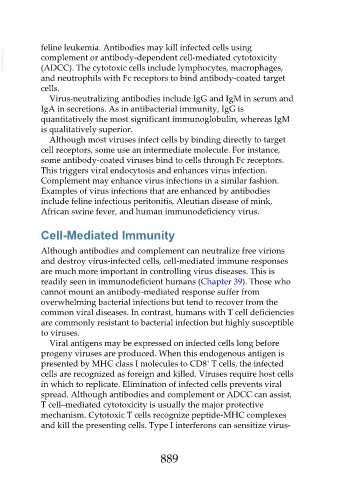Page 889 - Veterinary Immunology, 10th Edition
P. 889
feline leukemia. Antibodies may kill infected cells using
VetBooks.ir complement or antibody-dependent cell-mediated cytotoxicity
(ADCC). The cytotoxic cells include lymphocytes, macrophages,
and neutrophils with Fc receptors to bind antibody-coated target
cells.
Virus-neutralizing antibodies include IgG and IgM in serum and
IgA in secretions. As in antibacterial immunity, IgG is
quantitatively the most significant immunoglobulin, whereas IgM
is qualitatively superior.
Although most viruses infect cells by binding directly to target
cell receptors, some use an intermediate molecule. For instance,
some antibody-coated viruses bind to cells through Fc receptors.
This triggers viral endocytosis and enhances virus infection.
Complement may enhance virus infections in a similar fashion.
Examples of virus infections that are enhanced by antibodies
include feline infectious peritonitis, Aleutian disease of mink,
African swine fever, and human immunodeficiency virus.
Cell-Mediated Immunity
Although antibodies and complement can neutralize free virions
and destroy virus-infected cells, cell-mediated immune responses
are much more important in controlling virus diseases. This is
readily seen in immunodeficient humans (Chapter 39). Those who
cannot mount an antibody-mediated response suffer from
overwhelming bacterial infections but tend to recover from the
common viral diseases. In contrast, humans with T cell deficiencies
are commonly resistant to bacterial infection but highly susceptible
to viruses.
Viral antigens may be expressed on infected cells long before
progeny viruses are produced. When this endogenous antigen is
+
presented by MHC class I molecules to CD8 T cells, the infected
cells are recognized as foreign and killed. Viruses require host cells
in which to replicate. Elimination of infected cells prevents viral
spread. Although antibodies and complement or ADCC can assist,
T cell–mediated cytotoxicity is usually the major protective
mechanism. Cytotoxic T cells recognize peptide-MHC complexes
and kill the presenting cells. Type I interferons can sensitize virus-
889

